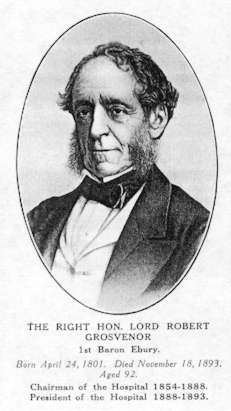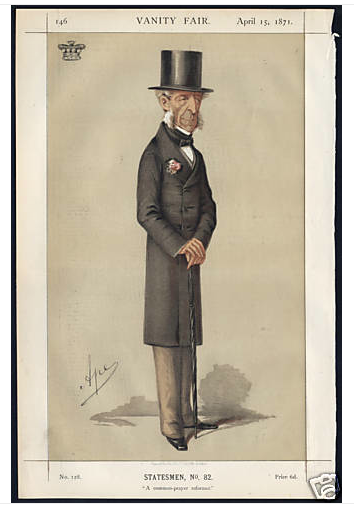Robert Grosvenor 1st Baron Ebury 1801 – 1893
January 18, 2009
 Robert Grosvenor 1st Baron
Ebury
PC
1801 – 1893 known as Lord Robert Grosvenor from 1831 to 1857, was a
British Whig politician, and the
brother
of Thomas Egerton 2nd Earl of
Wilton
and Richard Grosvenor Earl Grosvenor 2nd Marquess of
Westminster.
Robert Grosvenor 1st Baron
Ebury
PC
1801 – 1893 known as Lord Robert Grosvenor from 1831 to 1857, was a
British Whig politician, and the
brother
of Thomas Egerton 2nd Earl of
Wilton
and Richard Grosvenor Earl Grosvenor 2nd Marquess of
Westminster.
The British Homeopathic Association was originally founded in 1847 by Robert Grosvenor, Richard Walter Heurtley, John Epps, Marmaduke Blake Sampson and Thomas Uwins.
Robert Grosvenor was a colleague of the Marquis of Anglesea, Francis Black, Edward Charles Chepmell, Henry Charles FitzRoy Somerset 8th Duke of Beaufort, Edward Hamilton, Richard Walter Heurtley, John Stuart Mill, John Ozanne, Frederick Hervey Foster Quin, John Rutherford Russell and many others.
Grosvenor also supported the staff of the Hahnemann Hospital at 39 Bloomsbury Square. Ebury Ward at the London Homeopathic Hospital is named after him.
The British Homeopathic Society sought the help of Lord Robert Grosvenor, a Member of Parliament sympathetic to homeopathy. Following a question asked by him in the House of Commons, the homeopathic results were published, demonstrating the superiority of the system of treatment.
The supporters of homeopathy are now striving to establish a large metropolitan hospital, which shall be conducted according to the principles inculcated by Samuel Hahnemann, which will be a school for homeopathic students, and which will afford to allopathic physicians the means of inquiring into the merits of the new doctrine and practice.
A public dinner in aid of the building fund of this charity took place on Wednesday, April 21 at Willis’s Rooms, when Henry Charles FitzRoy Somerset 8th Duke of Beaufort, George Ponsonby O’Callaghan 2nd Viscount Lismore, Arthur de Vere Capell Viscount Malden, Henry Robinson Montagu 6th Baron Rokeby, Lord Grey de Wilton, Lord Cosmo Russell, the Hon. Robert Grosvenor, Mr Truman MP, Major Blake, Edmund Gardiner Fishbourne, Mr Pritchard [High Bailiff of Southwark], Mr Sheriff Rutherford, Frederick Hervey Foster Quin, John Rutherford Russell, and about 150 other gentlemen, known as supporters and practitioners of homeopathy in the metropolis and in the provinces.
The usual toasts were given, viz– “The Queen;” “The Prince Consort and the Royal Family;” and “The Army and Navy,” responded to by Henry Robinson Montagu 6th Baron Rokeby and Edmund Gardiner Fishbourne, who alluded to their experience of the benefits personally derived by them from homeopathy during their service in the Niger expedition and in the Crimea. The Chairman then proposed “Success to the London Homeopathic Hospital,” which was enthusiastically received.
The homeopathic hospital in Smyrna, was also supported by: Arthur Algernon Capell 6th Earl of Essex, Lord Lovaine MP (Algernon George Percy 6th Duke of Northumberland), James Gambier 1st Baron Gambier, George Wyndham 1st Baron Leconfield, Colonel Taylor, Edmund Gardiner Fishbourne, Robert Grosvenor 1st Baron Ebury, Richard Whately Archbishop of Dublin, Henry Charles FitzRoy Somerset 8th Duke of Beaufort, Arthur Wellesley 1st Duke of Wellington, James Hamilton 1st Duke of Abercorn, and 18 other members of the House of Lords, 43 Peer’s sons, Baronets and Members of Parliament, 17 Generals, 33 Field Officers, 43 other Officers of the Army, 2 Admirals, 15 Captains of the navy, 65 Clergymen, 45 Justices of the Peace, Barristers and Solicitors, and 314 Bankers, Merchants and others.
 In 1866, Robert Grosvenor was on
the Committee of the Association for the Trial of Preventative and
Curative Treatment in the Cattle Plague by the Homeopathic
Method,
with William Pitt Amherst 2nd Earl
Amherst,
Henry Charles FitzRoy Somerset 8th Duke of
Beaufort,
Ralph Buchan, William
Alleyne Cecil Lord Burghley 3rd Marquess of
Exeter,
George Thomas Keppel 6th Earl of
Albemarle,
William Coutts Keppel Viscount Bury 7th Earl of
Albemar
(the Earl of Albemarle’s son), James Key Caird 1st
Baronet
(Vice Chairman), Colonel Challoner, George Grimston Craven 3rd Earl of
Craven,
Henry William Dashwood 5th
Baronet,
Patrick Dudgeon, Francis Richard Charteris 10th Earl of Wemyss Lord
Elcho,
Arthur Algernon Capell 6th Earl of
Essex,
Richard Grosvenor Earl Grosvenor 2nd Marquess of
Westminster,
Philip Howard
Frere, Edward
Kerrison, Henry Charles Keith Petty Fitzmaurice 5th Marquess of
Lansdowne,
Lord Llanover, Colonel Farnaby Lennard, George
Loch,
Archibald Keppel MacDonald, Arthur de Vere Capell Viscount
Malden,
John Winston Spencer Churchill 7th Duke of
Marlborough
(Chairman), Frederick Francis
Maude,
William Miles, James
Moore, Charles
Gordon Lennox 5th Duke of
Richmond,
Charles Marsham 3rd Earl of
Romney,
Sir Anthony
Rothschild, John
Villiers
Shelley,
John Robert Townshend 1st Earl
Sydney,
Lt. Colonel Charles Towneley, Augustus Henry
Vernon,
William Warren
Vernon,
Arthur Richard Wellesley 2nd Duke of
Wellington (1807-1884),
William Wells,
In 1866, Robert Grosvenor was on
the Committee of the Association for the Trial of Preventative and
Curative Treatment in the Cattle Plague by the Homeopathic
Method,
with William Pitt Amherst 2nd Earl
Amherst,
Henry Charles FitzRoy Somerset 8th Duke of
Beaufort,
Ralph Buchan, William
Alleyne Cecil Lord Burghley 3rd Marquess of
Exeter,
George Thomas Keppel 6th Earl of
Albemarle,
William Coutts Keppel Viscount Bury 7th Earl of
Albemar
(the Earl of Albemarle’s son), James Key Caird 1st
Baronet
(Vice Chairman), Colonel Challoner, George Grimston Craven 3rd Earl of
Craven,
Henry William Dashwood 5th
Baronet,
Patrick Dudgeon, Francis Richard Charteris 10th Earl of Wemyss Lord
Elcho,
Arthur Algernon Capell 6th Earl of
Essex,
Richard Grosvenor Earl Grosvenor 2nd Marquess of
Westminster,
Philip Howard
Frere, Edward
Kerrison, Henry Charles Keith Petty Fitzmaurice 5th Marquess of
Lansdowne,
Lord Llanover, Colonel Farnaby Lennard, George
Loch,
Archibald Keppel MacDonald, Arthur de Vere Capell Viscount
Malden,
John Winston Spencer Churchill 7th Duke of
Marlborough
(Chairman), Frederick Francis
Maude,
William Miles, James
Moore, Charles
Gordon Lennox 5th Duke of
Richmond,
Charles Marsham 3rd Earl of
Romney,
Sir Anthony
Rothschild, John
Villiers
Shelley,
John Robert Townshend 1st Earl
Sydney,
Lt. Colonel Charles Towneley, Augustus Henry
Vernon,
William Warren
Vernon,
Arthur Richard Wellesley 2nd Duke of
Wellington (1807-1884),
William Wells,
In 1866, the Treasury placed rooms at Adelphi Terrace at the disposal of John Winston Spencer Churchill 7th Duke of Marlborough, who was the Chairman of the Association for the Trial of Preventative and Curative Treatment in the Cattle Plague by the Homeopathic Method, based on the research done in Belgium by Edward Hamilton, with John Winston Spencer Churchill 7th Duke of Marlborough overseeing the work of Edward Hamilton, George Lennox Moore, James Moore and Alfred Crosby Pope.
William Coutts Keppel Viscount Bury 7th Earl of Albemarle issued an address or report for the Association for the Trial of Preventative and Curative Treatment in the Cattle Plague by the Homeopathic Method in 1866. Bury reported that the Dutch had experienced such success with homeopathy against that cattle plague, that they had authorised Edward Hamilton to visit Holland to investigate this.
Edward Hamilton discovered that the Dutch had treated 4798 cattle, 1031 were destroyed = 3767 were treated (with a mixture of allopathic and homeopathic treatments), the survival rate for the beasts treated was 45%, and the survival rate for the beasts treated only by homeopathy was 72-5%.
The Dutch Government had agreed to allow E Seutin, a homeopathic chemist, the total control of infected cattle in Matterness, and initially, E Seutin saved 70% of the cattle, though latterly, he had saved 9 out of every 10 beasts brought to him for treatment, and E Seutin’s use of homeoprophylaxic treatment of unifected beasts brought the epidemic under control entirely within four weeks. Matterness was pronounced free from infection and it has remained thus ever since. The remedies used were arsenicum, phosphorus, phos ac, rhus tox and sulphur.
In 1866, George Lennox Moore became involved with Association for the Trial of Preventative and Curative Treatment in the Cattle Plague by the Homeopathic Method, alongside Edward Hamilton and Alfred Crosby Pope, and overseen by John Winston Spencer Churchill 7th Duke of Marlborough.
George Lennox Moore wrote a detailed report on these trials, including a refutation of the falsities published in _The Lancet__ _regarding the homeopathic treatment of the cattle plague, attacking William Coutts Keppel Viscount Bury 7th Earl of Albemarle and accusing him of ‘being completely misinformed on this matter‘, and inventing a trail of misleading mistruths about the situation.
The orthodox statistics of this clinical trial revealed 8640 cases, 8% killed, 77% died and 15% recovered, though John Winston Spencer Churchill 7th Duke of Marlborough subsequently issued the interim homeopathic results claiming up to 50% recovery rates with arsenicum, belladonna, phosphorus, rhus tox and turpentine as the main homeopathic remedies used.
The final report on the homeopathic trials in the treatment of cattle plague was issued by John Winston Spencer Churchill 7th Duke of Marlborough. The orthodox statistics of this clinical trial revealed 8640 cases, 8% killed, 77% died and 15% recovered, though John Winston Spencer Churchill 7th Duke of Marlborough subsequently issued the interim homeopathic results claiming up to 50% recovery rates with arsenicum, belladonna, phosphorus, rhus tox and turpentine as the main homeopathic remedies used.
Grosvenor was the third son of Robert Grosvenor, 1st Marquess of Westminster and his wife Eleanora, daughter of Thomas Egerton, 1st Earl of Wilton.
He was the younger brother of Richard Grosvenor Earl Grosvenor 2nd Marquess of Westminster and Thomas Egerton 2nd Earl of Wilton, who had succeeded their maternal grandfather in the earldom of Wilton 1814, while Hugh Lupus Grosvenor, 1st Duke of Westminster and Richard Grosvenor, 1st Baron Stalbridge were his nephews.
Grosvenor was educated at Westminster School and Christ Church, Oxford. In 1821 he was elected to Parliament for Shaftesbury, a seat he held until 1826, and then sat for Chester until 1847.
When the Whigs came to power in November 1830 under Charles Grey 2nd Earl Grey, Grosvenor was appointed Comptroller of the Household and admitted to the Privy Council. He retained this office also when Lord Melbourne became Prime Minister in July 1834.
The Whig government fell in November the same year.
Grosvenor did not serve in Melbourne’s second administration which lasted from 1835 to 1841.
However, when the Whigs returned to office in 1846 under Lord John Russell he was made Treasurer of the Household, which he remained until July
- The latter year Grosvenor was elected to Parliament for Middlesex, a seat he held until 1857.
However, he never returned to office.
In September 1857 he was raised to the peerage as Baron Ebury, of Ebury Manor in the County of Middlesex.
Apart from his political career Lord Ebury was an active campaigner for Protestantism in the Church of England, and was the founder and President of the society for the “revision of the prayer book”.
He was also involved in the movement led by Anthony Ashley Cooper, 7th Earl of Shaftesbury for the improvement of factory working hours. In later life he came to oppose William Gladstone on the issue of Irish Home Rule.
In September 1893, at the age of 92, Lord Ebury voted against the Second Home Rule Bill, by far the oldest peer to vote in the matter.
Lord Ebury married Charlotte Arbuthnot Wellesley eldest daughter of Henry Wellesley, 1st Baron Cowley, in 1831. They had five sons and two daughters one of them was the Honourable Algernon Henry Grosvenor.
Lord Ebury died in November 1893, aged 92, and was succeeded in the barony by his eldest son Robert Wellesley Grosvenor.